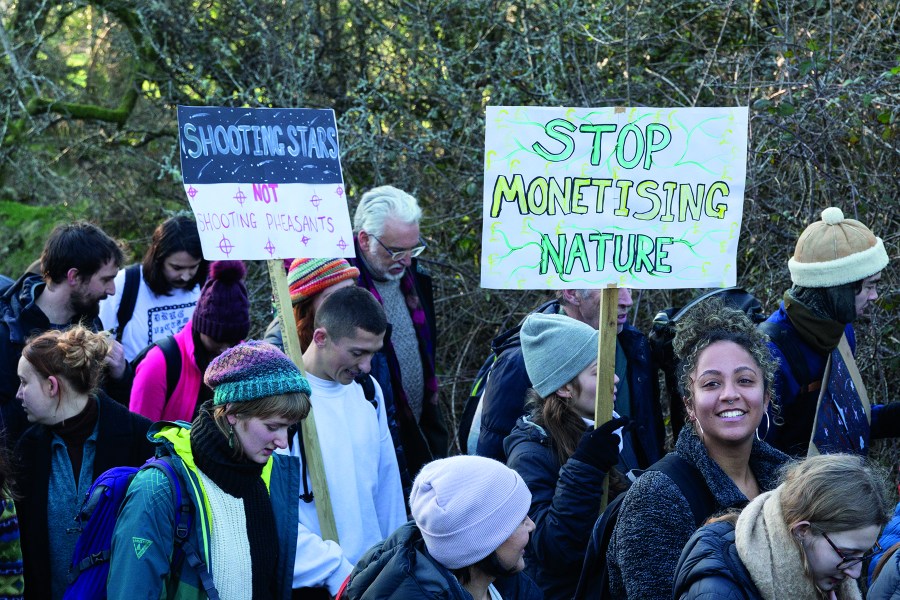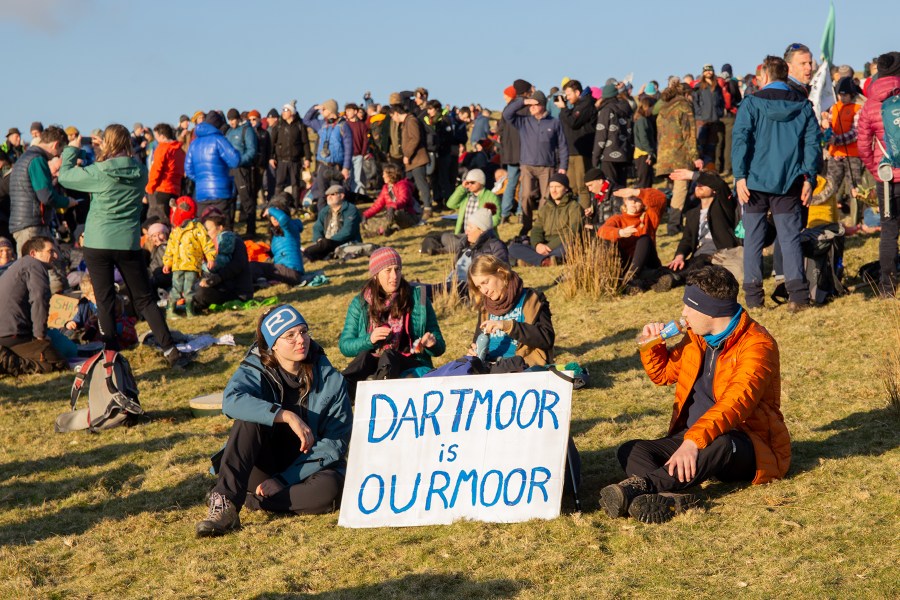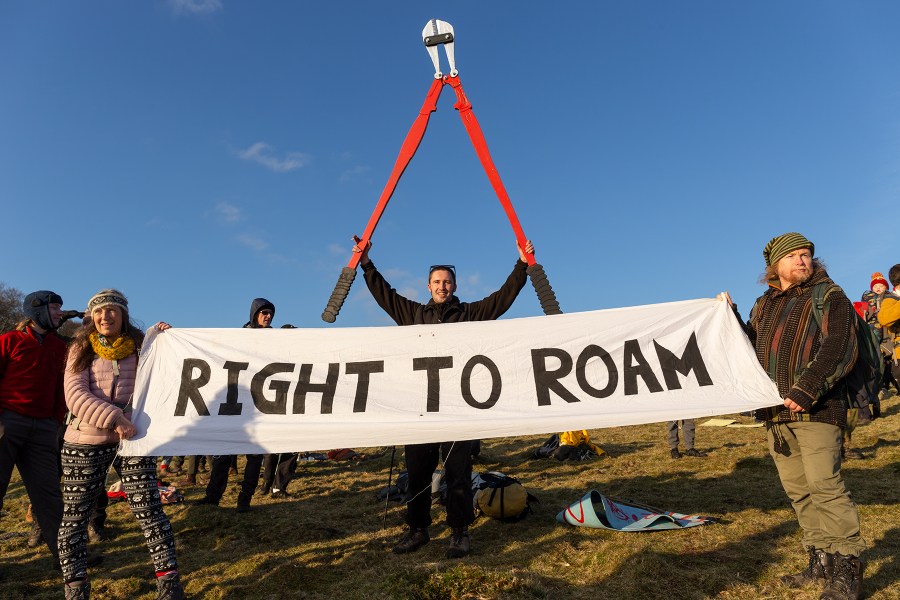Anger over Dartmoor has given England’s right to roam movement new energy. But what happens next? Campaigner Jon Moses looks ahead…
An irony of campaigning is that the biggest breakthroughs are often the result of apparent defeats. So it was this month, as multi-millionaire hedge fund manager, Alexander Darwall, won a legal case which resulted in the abolishment of the right to roam of millions of people to sleep under the stars in Dartmoor national park.
In the case brought against the Dartmoor National Park Authority (DNPA), Darwall’s lawyers argued that the 1985 Dartmoor Commons Act act did not include camping overnight, as it did not explicitly mention it. Judge Julian Flaux ruled that this was correct, a decision which absurdly hinged on whether wild camping counted as one of the ‘recreational activities’ included in the act.
Words: Jon Moses | Main image: Symbolic bolt-cutters wielded at the Jan 21 Dartmoor protest | Photo: Ross Crawford
The DNPA has since reached an ‘agreement’ with landowners, which will grant permission to the authority to allow the public to wild camp on a smaller area of land than before through a permissive agreement. This is nothing but a stitch-up, swapping rights for ‘permission’ which could be rescinded, and which could even involve some kind of public payment to landowners.
In any case, as the last place in England or Wales where it was still legally possible to wild camp without asking permission of the landowner (in practice, a very difficult thing to obtain), the Dartmoor case has clearly struck a nerve with the public – even among those had the least desire to pitch a tent.
Dartmoor protest
Weeks before the high court decision, with no clear end to the court proceedings in sight, Right to Roam and The Stars Are For Everyone had pencilled in a small ceremonial event on Stall Moor (the chunk of upland owned by Mr Darwall) to raise ‘Old Crockern’ – a tellurian avatar with a penchant for cursing greedy landowners.
We guessed about 30 people might come. One bad verdict later, 4,000 had signed up.
What followed was one of the largest land justice protests in a generation. The narrow streets of the tiny village of Cornwood, where Mr Darwall resides, became gridlocked with giant puppets and protest signs.

4,000 people signed up for the Jan 21 protest. Photo: Jon Moses
It was clear Dartmoor had caught the public imagination, and astute politicians were not far behind. The Labour shadow Defra secretary, Jim McMahon raced to the southwest to formally announce his party’s commitment to a Right to Roam Act. Local Liberal Democrat candidate, Caroline Voaden, pledged much the same.
With the Greens already well ahead on the issue (Caroline Lucas has been promoting a Right to Roam Bill since last year), a wide political consensus has been formed: the right to roam is due for a significant expansion. For this we must give thanks to comrade Darwall, who has single-handedly done more for our cause than we ever could ourselves.
Overcrowded England?
If some kind of English Right to Roam Act is now highly likely, the next political struggle will be over what it actually looks like. The obvious model is right across the border. Scotland has enjoyed a ‘full’ right to roam since 2005, with responsible access for recreational and educational purposes enshrined on most areas of land. There are sensible exceptions: gardens, construction sites, crop-bearing fields. But the principle is clear: the default is access and exclusion an exception – not a norm.
The merits of such an approach are twofold. Firstly, it removes the ability of wealthy landowners to arbitrarily dictate how the majority of us exist in the countryside. No small matter, as Mr Darwall has made clear. But there are advantages from a policy perspective too. It’s simple to communicate and avoids the definitional wrangling which dogged the original Countryside and Rights of Way Act (2000). That led to watered-down legislation (in which water access itself was all but abandoned) and absurdities such as so-called ‘access islands’: areas of land where the public theoretically has a right to roam, but no lawful means of accessing them (except by parachute).

Protesters head out of Cornwood for the moor. Photo: Right to Roam
It was also extremely uneven: open access land covers 72% of the Peak District, but just 0.6% of Kent. A more powerful settlement on rights could buy political space for less popular measures on responsibilities – like regulating dog ownership – and makes sensible exclusions for wildlife conservation easier to accommodate amid the broader extension of access elsewhere.
But it would likely face strong opposition in England, where it is argued that higher population density makes such comprehensive access impossible. We should be sceptical of such claims. While the density is certainly smaller, the population spread of Scotland is not so different to its more populous neighbour, with large numbers of people occupying cities in the Central Belt and east coast in close proximity to hotspots such as Loch Lomond and the Cairngorms. The orthodoxy that England is a crowded little place is as much a product of right-wing political fantasies – and centuries of being crammed into the same little parts of it – as anything to do with geographical fact.
Deeper laws
Still, politicians are creatures of caution, and worries about confronting such arguments head on could lead to a more incremental approach. This would ‘build up’ from the 8% of access land the CRoW Act introduced, rather than ‘wind down’ from an access default, possibly including particular land use categories such as woodland, greenland, green belt and rivers – as already proposed in Caroline Lucas’s Bill.
That too would represent a significant expansion of rights, while helping avoid a fight over the most politically sensitive land types (such as farmland fringe). It’s why the Right to Roam campaign has been calling for it as a starting point since we launched two years ago. But there are also drawbacks: leaving large parts of the arable east and midlands with little more than it already has. It will also require a complex new network of access paths to link new areas of open access together. Less rights could also leave less opportunities for the new settlement we need with nature, which extends well beyond the question of who can go where.

The Dartmoor protest was the largest land justice protest in a generation. Photo: Ross Crawford
Whatever path the politicians decide, Right to Roam will be pushing for the most bold and comprehensive policy we can get. An end to the era where a tiny minority of landowners can decide how, when and on what terms we relate to the natural world, is surely long overdue.
In the meantime, don’t be cowed by misanthropes who view the earth as cash currency and its creatures through a gun scope. Take your night under the stars. There are deeper laws than mere courts can express.
Jon Moses is a writer on ecology and countryside and organiser for the Right to Roam campaign








